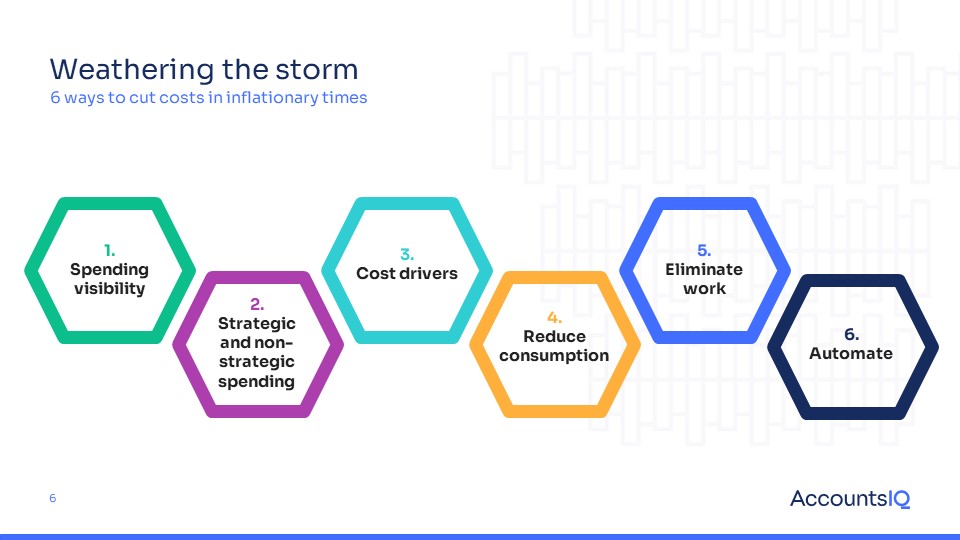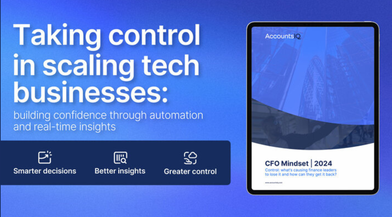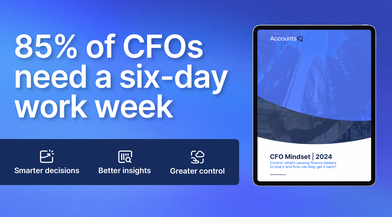
With inflation likely to remain relatively high for the next year and the looming threat of recession, many companies are looking at ways to weather the storm. Sometimes, we can learn from history. When Harvard Business Review (HBR) analysed the performance of 5,700 global companies during the Great Recession of 2008, they found that:
“Those that cut costs to improve productivity…achieved higher total shareholder returns (TSR) — 27%* was the median — than companies that took less action.”
The evidence, they argue, is clear. Companies can deal with inflation by adjusting prices or finding new sources of growth, but:
“Cutting costs remains an important part of managing in this economic environment.”
*Source: 6 Strategies to Help Your Company Weather Inflation, HBR, September 28, 2021.
AccountsIQ’s COO, Darren Cran, discussed this topic recently in his presentation at the SuperReturn Private Equity conference in Amsterdam. He outlined 6 ways CFOs can control costs in inflationary times:

1. Spending visibility
This is the foundation of any expense management capability. It enables managers across the business to fully understand and account for where money is spent and who spends it. They can also see the full impact on the P&L.
Every business needs to establish repeatable, end-to-end, actionable visibility of spending by cost category, business process, function, and business unit.
Alex Gilbert, CFO with AccountsIQ customer David Chipperfield Architects, comments on the need for reliable and real-time data to ensure they’re driving the business in the right direction:
“Each project now has its own dashboard that finance can share with project teams and architects…we ensure everyone has complete visibility on how their projects are going…This helps with our cashflow forecasting because we know what expenses are coming down the line.”
2. Strategic and non-strategic spending
Inflation adds to the pressure to cut costs. But any cuts must still align with the long-term strategy of the business. As such, CFOs need to differentiate between strategic and non-strategic spending initiatives.
For example, in his article, CFOs, Use Technology in Your Inflation Fight, Gartner’s Alexander Bant argues that digital initiatives should be seen through a different lens.
“Well-planned and implemented digital initiatives must have a long-term deflationary effect on business costs and, subsequently, the price of products or services. We call this digital deflation—investing in technology to permanently reduce the cost of doing business.”
Alexander Bant, Practice Vice-President Finance, Gartner
Investing in Financial Management Software ensures you have consistent, easily accessible financials to help you identify:
- Where you can realise operational cost savings
- Where you can boost growth or productivity by prioritising higher ROI projects and strategic investments.
3. Cost drivers
Businesses need a robust, granular, trackable view of the real and underlying drivers of their costs. This spending data underpins everyday business decisions, from selecting suppliers to identifying short-term cost savings. It also enables you to advance to the next three tactics.
4. Reduce consumption
Once you have full visibility of your spending and you can identify your cost drivers, you’re in a better position to take evidence-based decisions about what cost savings steps to take. As well as having the right finance system in place, this normally also involves a degree of cultural change. To be effective, spending controls and efficiency drives need to be cross functional and collaborative.
In one of our CFO webinars, Joanna McGovern, Finance Director with AccountsIQ customer Chopstix Group, described how automating and integrating their finance tech stack enabled them to identify key cost drivers. That meant they could start having meaningful conversations across their business about inefficiencies and cost savings.
“We now have more understanding of what’s driving the data. Behind every key line on the P&L, we have a suite of analysis to make sure we understand what’s happening."
“For example, we can now see how much chicken is wasted each week by individual restaurants. Over the course of a year, that saves us a lot of money. We also know exactly how many team members we need in each restaurant on specific days and times. We’ve got all the operational metrics and we can see where the leaks are with a click of a button.”
Joanna McGovern, Finance Director, Chopstix
Read more about finance automation and cost savings in our blog.
5. Eliminate work
The HBR study concluded that eliminating work can, potentially, have the greatest impact of any of these six strategies. It involves companies using a clean-sheet mindset, or zero-based redesign, to scrutinise what activities are performed, how those activities are performed, what adds most value and what is absolutely necessary. Then – often difficult – decisions can be made about what work can be eliminated altogether and what can be automated.
6. Automate
Automating manual activities can have a big impact on costs and productivity. Many companies could score some quick digital wins with, for example, automated Accounts Payable (AP) and bank feeds. Joanna McGovern, Finance Director with Chopstix, explains:
“Our most impactful automation has been AP. We work with iCompleat; it integrates seamlessly with AccountsIQ and it all flows through with almost no manual intervention. In other hospitality businesses I’ve worked in, there have been six to seven people in AP; we have one and they mostly deal with queries rather than processing.”
Find out more about AccountsIQ’s Integrated Accounting Software.
Multi-dimensional reporting Webinar
Join our live demo webinar to find out how multi-dimensional analysis and reporting can help CFOs manage costs and cashflow



